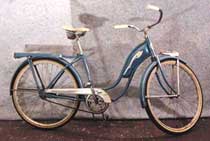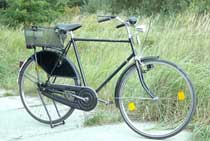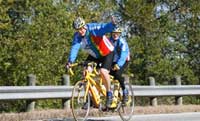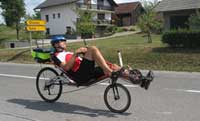Staying Safe on the Road Types of Bicycles
In the United States, motorized vehicles rather quickly edged out the bicycle for transportation. Bicycles came to be ridden chiefly by children, for whom a fairly simple but durable bike was deemed appropriate. Through the mid-1900s, therefore, the standard American bicycle was the cruiser. With a heavy frame, balloon tires, a single gear, and coaster brakes, which operated by pushing backward on the pedals, this sturdy type of bicycle went everywhere.
|
The cruiser bicycle, seen here in a 1960s Rollfast Space ladies model, was popular for children in the United States. It had a heavy frame, wide balloon tires, one gear, and pedal brakes. |
The utility bicycle, so-named because it has all sorts of uses, is popular throughout Europe, where people ride to get around, rather than solely for recreation. This bicycle has three speeds and thinner tires. |
In Europe, where bicycles remained a method of transportation as well as a popular form of adult recreation, a lighter bicycle developed. It had thinner tires and three-speed hub gears as well as hand-operated brakes on the rim of the wheels, or sometimes drum brakes (which are attached to the hub of the wheel). Some had step-through frames, which made them easier for women in skirts to use. This model became known as the utility bicycle because it was (and is) a basic means of getting about, used for going to and from work, shopping and other errands, and perhaps getting out of town on the weekends. This bike continues to be used in many parts of the world for just those purposes. Not infrequently a child seat is mounted behind or in front of the rider. There are also various kinds of bike trailers for this type of bicycle, designed to carry children and different kinds of cargo.
In the early part of the 20th century, cycling vacations became quite the thing, especially for wealthy people, at least, before they had cars. A special model of bicycle developed for touring. This bike was designed to carry heavy loads on racks to the front and rear and thus had a sturdier frame and wheels. Some of these bicycles could be ridden by two people—the tandem bicycle.
Toward the end of the 20th century, the recumbent bicycle, a completely different style of bike, achieved some popularity for touring. This style had been around since early in the bicycle era but was largely neglected. On a recumbent bicycle the rider sits slightly reclined in a high-backed seat with his or her legs stretched almost straight ahead to the pedals, which are about the same height as the seat. The riding position of the recumbent makes it comfortable for long distances. It is also aerodynamically efficient. Because of the latter quality, the recumbent holds the world speed record for bicycles. It was banned from actual bicycle racing, however, as early as 1934 because it was thought to give an unfair advantage.
|
A tandem bicycle is built for two riders. It is mostly used for recreation. |
The wide knobby tires, heavier frame, and many gears give the mountain bike the power to travel over rough terrain. |
The recumbent bicycle, used for recreational riding, causes less stress on the back. |
A special bicycle developed for road racing. Its aerodynamic efficiency is the result of a raised seat and lower handlebars, which curve downward (they are known as drop handlebars). This type of bicycle is made of lightweight materials and has a short wheelbase, for quick handling. Its derailleur gears have 5 to 15 closely spaced speeds.
Beginning in the late 1960s, adults in the United States began to rediscover bicycles. The bicycle retained its popularity in the 1970s due to the rising oil prices of that time. Mostly, however, they turned to bicycles for recreation and exercise. The European racing models gained popularity in the United States. Racing bikes, however, are not very comfortable, and their narrow tires are not suitable for off-road conditions.
The mountain bike, developed in the late 1980s, rose to popularity in the early 1990s. It features a heavier frame, wide tires with knobby treads, suspensions systems, and flat handlebars, which restore the rider to an upright position. These bicycles also have even more gear speeds, as many as 21 to 27, for going up and down steep slopes. Although mountain bikes were originally designed for off-road use, riders soon took them onto the roads. Eventually a hybrid style came along, combining features of the mountain bike and the racing bicycle to make a more suitable vehicle for ordinary road use.
No discussion of bicycle types is complete without considering motorized bikes. As soon as the bicycle was invented, people began putting motors on them. Electric motors were tried and then largely abandoned for close to a century. As with cars, the gasoline-powered internal combustion engine won the day, leading to the development of motorcycles and related vehicles. However, some bicycle builders attached a small motor to create the power-assisted bicycle. The rider still relies primarily on pedal power, using the motor for extra speed and mounting hills. Increasingly, with improved battery technology, the motors are electric, with regenerative brakes to help recharge the batteries. These are called e-bikes. Some European countries provide charging stations for e-bikes.
Not all bicycles are used for transportation or recreation. Some riders use them for racing. Many different types of competitions are held, for all different types of bicycles.
This content has been re-published with permission from SEED. Copyright © 2025 Schlumberger Excellence in Education Development (SEED), Inc.






